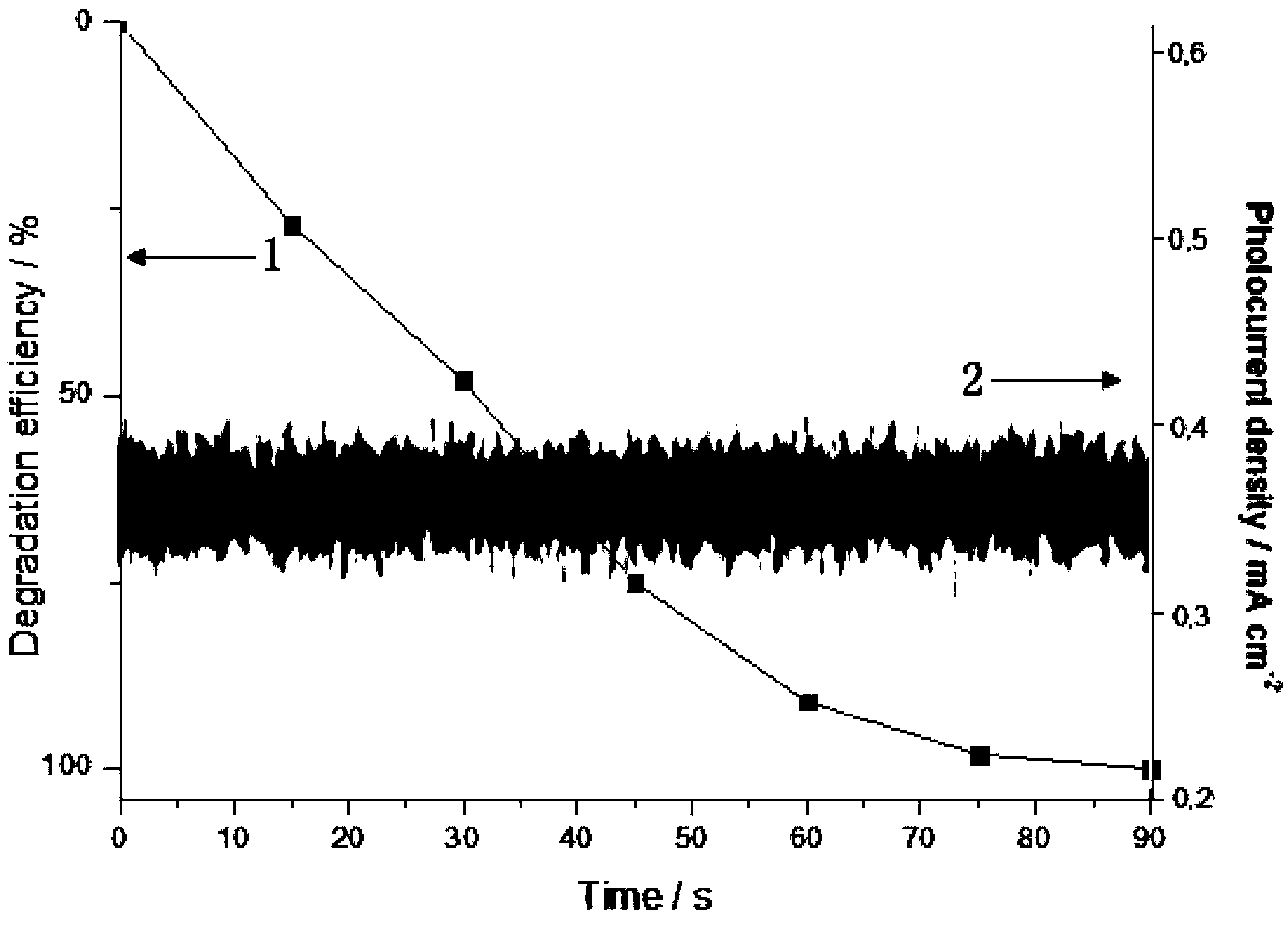Visible-light response type photocatalysis wastewater fuel cell, manufacture method thereof and application thereof
A fuel cell and visible light technology, used in fuel cells, battery electrodes, energy and wastewater treatment, etc., can solve problems such as the inability to support the stable operation of the battery system, the inability to meet the long-term stable operation, and the sharp increase in the cost of photocatalytic fuel cells. The effect of good photocatalytic performance, good visible light response, significant organic degradation performance and power generation performance
- Summary
- Abstract
- Description
- Claims
- Application Information
AI Technical Summary
Problems solved by technology
Method used
Image
Examples
preparation example Construction
[0028] The preparation method of the visible light-responsive photocatalytic waste water fuel cell of the present invention, it comprises:
[0029] 1) To prepare the platinum-modified silicon cell photocathode, the method is: weld copper wires on the back field of a cleaned commercial silicon cell, and then use insulating epoxy resin on the back field of the silicon cell Seal, after sealing, take the silicon cell as the working electrode and place it in a 2 PtCl 6and 0.1M sodium sulfate in 1M sulfuric acid solution, using platinum electrode as the counter electrode, controlling the working voltage to -0.5V, and the electrodeposition time is 30min, to carry out the platinum modification of the silicon battery sheet, and the silicon battery sheet modified by platinum with distilled water Repeated soaking to remove surface residues, and then drying to obtain a platinum-modified silicon cell photocathode.
[0030] 2) Prepare the WO 3 / W nanohole array photoanode, the method is:...
Embodiment 1
[0035] Firstly, copper wires are welded on the back field of the cleaned commercial silicon cell, and the back field of the silicon cell is sealed with insulating epoxy resin, and then the treated silicon cell is used as the working electrode, placed in a 10mM K 2 PtCl 6 and 0.1M sodium sulfate and 1M sulfuric acid solution, with a platinum electrode as the counter electrode, the operating voltage is controlled at -0.5V, and the electrodeposition time is 30min. The treated silicon cell is repeatedly soaked in distilled water to remove the residue on the product surface. Then dry it to obtain the platinum catalyst-modified silicon cell photocathode.
[0036] Use the cleaned metal tungsten plate as the anode, place it in 0.1M sodium sulfate solution containing 0.5% sodium fluoride, use the platinum electrode as the counter electrode, and control the voltage increase rate to 1V s -1 , stabilized at 50V for 30 minutes to obtain the initial material of the tungsten-based tungsten ...
Embodiment 2
[0046] Using platinum-modified silicon cells as photocathode 2, WO 3 / W nanopore array is photoanode 1, photocathode 2 and photoanode 1 are respectively inserted into 0.05M sodium sulfate solution containing 5mg / L methylene blue, and connected through external circuit 3. Turn on the simulated sun light source (the light intensity is 100mW cm -2 ) to irradiate photoanode 1 and photocathode 2, and continue to pass air near photocathode 2. At this time, the oxygen in the air combines with photogenerated electrons generated by photocathode 2, methylene blue is oxidized near photoanode 1, and photoanode 1 generates The photo-generated electrons are transmitted to the photocathode 2 through the external circuit 3 and combined with the photo-generated holes generated by it, and at the same time realize the degradation and power generation of methylene blue. The visible light-responsive photocatalytic waste water fuel cell of the present invention can remove almost all methylene blue...
PUM
| Property | Measurement | Unit |
|---|---|---|
| Photocurrent density | aaaaa | aaaaa |
Abstract
Description
Claims
Application Information
 Login to View More
Login to View More - R&D
- Intellectual Property
- Life Sciences
- Materials
- Tech Scout
- Unparalleled Data Quality
- Higher Quality Content
- 60% Fewer Hallucinations
Browse by: Latest US Patents, China's latest patents, Technical Efficacy Thesaurus, Application Domain, Technology Topic, Popular Technical Reports.
© 2025 PatSnap. All rights reserved.Legal|Privacy policy|Modern Slavery Act Transparency Statement|Sitemap|About US| Contact US: help@patsnap.com


